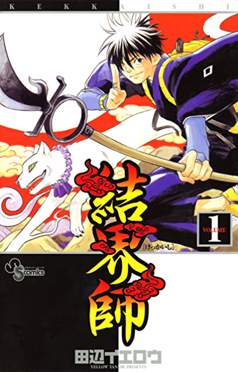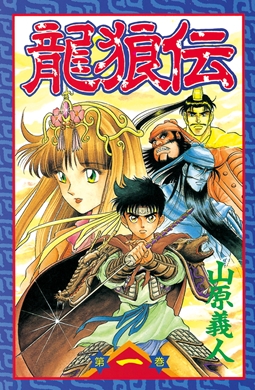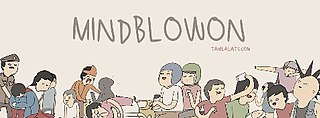
Manga are comics or graphic novels originating from Japan. Most manga conform to a style developed in Japan in the late 19th century, and the form has a long history in earlier Japanese art. The term manga is used in Japan to refer to both comics and cartooning. Outside of Japan, the word is typically used to refer to comics originally published in the country.

Weekly Shōnen Jump is a weekly shōnen manga anthology published in Japan by Shueisha under the Jump line of magazines. The manga series within the magazine consist of many action scenes and a fair amount of comedy. The chapters of the series that run in Weekly Shōnen Jump are collected and published in tankōbon volumes under the Jump Comics imprint every two to three months. It is one of the longest-running manga magazines, with the first issue being released with a cover date of August 1, 1968.

m&c! Publishing or better known as m&c! is a publishing company in Indonesia. The company has its roots on Komik Majalah in the 1980s, which often published various comics from foreign publishers. In 2003, m&c! was established as a publishing company and is part of the Retail and Publishing Division of the Kompas Gramedia Group (KGG). m&c! headquartered in the Kompas Gramedia Palmerah building, located in Tanah Abang, Central Jakarta.

Nakayoshi is a monthly shōjo manga magazine published by Kodansha in Japan. First issued in December 1954, it is a long-running magazine with over 60 years of manga publication history. Notable titles serialized in Nakayoshi include Princess Knight, Candy Candy, Pretty Guardian Sailor Moon and Cardcaptor Sakura. Roughly the size of a phone book, the magazine generally comes with furoku, or small gifts, such as pop-out figures, games, small bags, posters, stickers, and so on. The furoku is an attempt to encourage girls to buy their own copies of the magazine rather than just share with a friend.

Kekkaishi is a Japanese manga series written and illustrated by Yellow Tanabe. It was serialized in Shogakukan's shōnen manga magazine Weekly Shōnen Sunday from October 2003 to April 2011, with its chapters collected in 35 tankōbon volumes. The series is about Yoshimori Sumimura and Tokine Yukimura, heirs to rival families of kekkai users, who must defend their school from the spirits drawn to the sacred land upon which it is built.
Shonen Magz was a Shōnen-oriented manga magazine published monthly by Elex Media Komputindo. It was the Indonesian version of the Japanese Shōnen Magazine and therefore, contained Kodansha-published works only. It was published shortly after the success of the local edition of Nakayoshi.

Kompas Gramedia is an Indonesian conglomerate. It has focused on several businesses, predominantly mass media, as well as hospitality, manufacturing, and event organizing.
Winnie the Pooh is a 1978-1988 daily comic strip based on the Winnie-the-Pooh characters created by A.A. Milne in his 1920s books. The strip ran from June 19, 1978, until April 2, 1988. This is one of many Disney comic strips that have run in newspapers since 1930.

Riichiro Inagaki is a Japanese manga writer from Tokyo. He started his career in 2001 publishing works for Shogakukan's magazine Big Comic Spirits. After three one-shots, he moved to Shueisha's Weekly Shōnen Jump, in which he started the work he is best known for, Eyeshield 21. In collaboration with the artist Yusuke Murata, Eyeshield 21 was serialized between July 2002 and June 2009 in Weekly Shōnen Jump. Between 2010 and 2015, Inagaki collaborated with several artists, including Bonjae, Katsunori Matsui, and Ryoichi Ikegami, and published one-shots in different magazines. He started a new serial titled Dr. Stone in Weekly Shōnen Jump in 2017 in collaboration with Boichi. He has 3 children with Orie Kimoto.

Ryūrōden, translated as Legend of the Dragon's Son, is a Japanese manga series written and illustrated by Yoshito Yamahara. It was serialized by Kodansha in Monthly Shōnen Magazine from 1993 to 2007 and collected in 37 tankōbon volumes; in 2005 it was reprinted in 10 bunkoban volumes. In 1997, it won the Kodansha Manga Award for shōnen manga. It is followed by a sequel series, Ryūrōden: Chugen Ryōran-hen, which was serialized in Monthly Shōnen Magazine from 2007 to 2016 and collected in 17 volumes and later Ryūrōden: Ouha Rikkoku-hen from 2016 to present and collected in 7 volumes.
Shōnen, shonen, or shounen is the Japanese word for "boy" or "minor".
Shōnen Star was the Indonesian version of Weekly Shōnen Sunday published by Elex Media Komputindo, the largest comic publisher in Indonesia in 2005. The magazine published Kurozakuro, Robot Boys, My Wing, Midori's Days, etc. Due to government regulation of pornography so the censorship was considered to be too strict. Formerly the magazine had been published monthly but as of July 2010 the magazine was published twice a month. In November 2013 the magazine was cancelled at volume 16.
Hanalala was the Indonesian version of the manga magazines Hana to Yume and LaLa. The magazine was started in 2006. It was published by Elex Media Komputindo, a component of Kompas Gramedia Group, the largest comic publisher in Indonesia. Publication was discontinued with a Farewell Edition on 2 December 2010.

Kodansha Ltd. is a Japanese privately-held publishing company headquartered in Bunkyō, Tokyo. Kodansha produces the manga magazines Nakayoshi, Afternoon, Evening, Weekly Shōnen Magazine and Bessatsu Shōnen Magazine, as well as the more literary magazines Gunzō, Shūkan Gendai, and the Japanese dictionary Nihongo Daijiten. Kodansha was founded by Seiji Noma in 1910, and members of his family continue as its owners either directly or through the Noma Cultural Foundation.

Tahilalats, also known as Mindblowon, is an Indonesian-language webcomic which is created, written and illustrated by Nurfadli Mursyid. First published through the Instagram account @tahilalats in 2014, the daily four-panel comic is one of the most-followed webcomics in Indonesia, being published primarily via WEBTOON and social media platforms such as Instagram and Facebook. The webcomic follows the slice of life genre, generally with the addition of over-exaggerated, absurd twists.

Blue Box is a Japanese romantic comedy and sports manga series written and illustrated by Kōji Miura. It has been serialized in Shueisha's Weekly Shōnen Jump since April 2021, with its chapters collected into nine tankōbon volumes as of February 2023.











